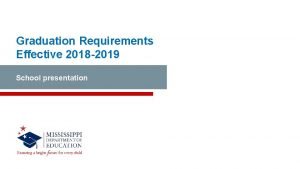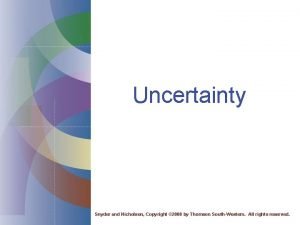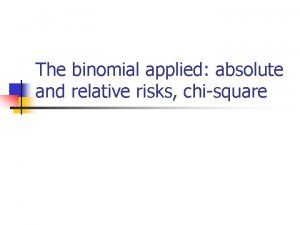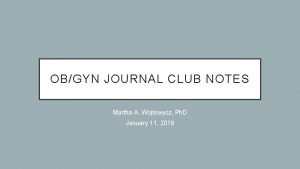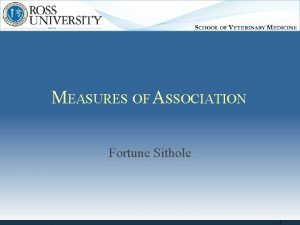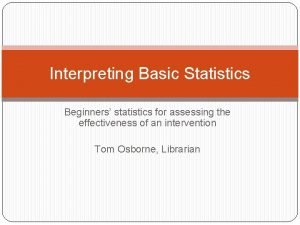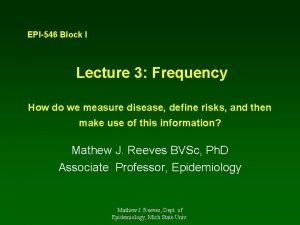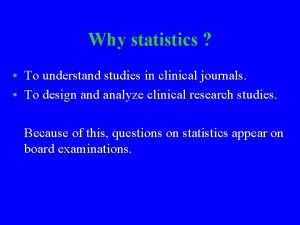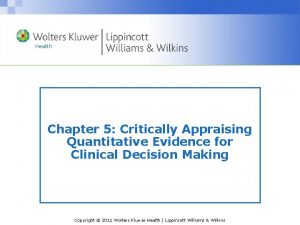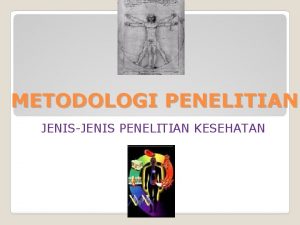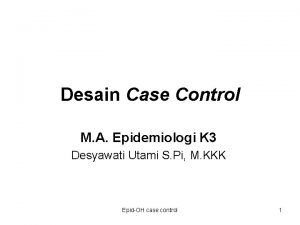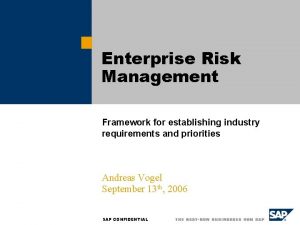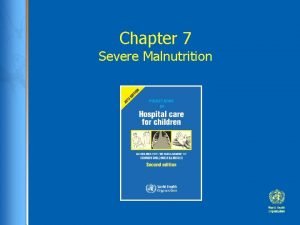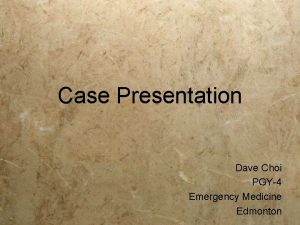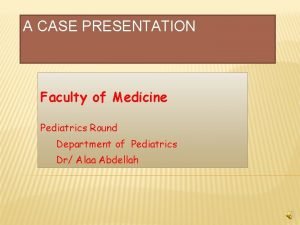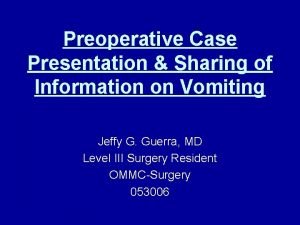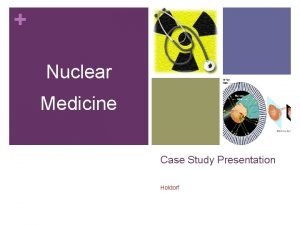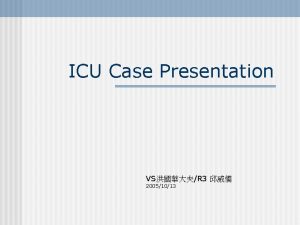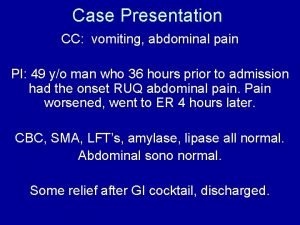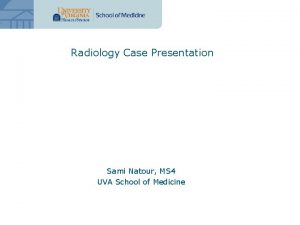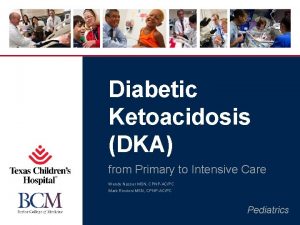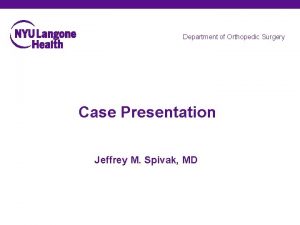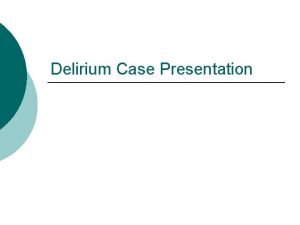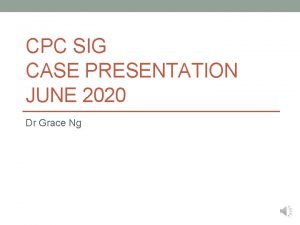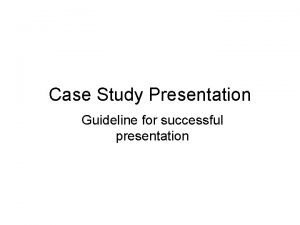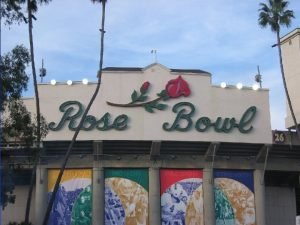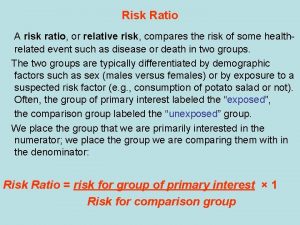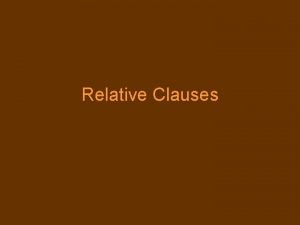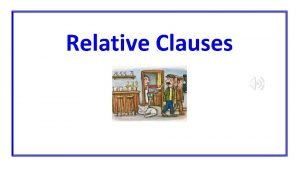Case presentation 17 JAN 2018 RELATIVE RISK Relative




































































- Slides: 68

Case presentation 17 JAN 2018

RELATIVE RISK Relative Risk of Progression of Diabetic Complications Mean A 1 C DCCT Research Group, N Engl J Med 1993, 329: 977986.

Macrovascular Complications as the most important cause of mortality • UKPDS • ADVANCE • VADT • ACCORD • Glycemic control per se doesn't decrease CVD outcome

Primary Objectives of Effective Management A 1 C % 9 l. Gæde P, Vedel P, Larsen N, Jensen GVH, Parving H-H, Pedersen O. Multifactorial intervention and cardiovascular disease in patients with type 2 diabetes. N Engl J Med. 2003; 348: 383 -393. Diagnosis 8 7 Reduction of both micro- and macro vascular event rates …by 75%! SBP mm Hg 145 130 LDL mg/d. L 140 100 45 50 55 60 65 70 75 Patient Age 80 85 90




Multiple, Complex Pathophysiological Abnormalities in T 2 DM GLP-1 R agonists Insulin Glinides S U s incretin effect DPP-4 inhibitors Amylin mimetics _ AGIs gut carbohydrate delivery & absorption pancreatic insulin secretion pancreatic glucagon secretion DA ? agonists HYPERGLYCEMIA Metformin _ Bile acid sequestrants + hepatic glucose production renal glucose excretion TZDs peripheral glucose uptake Adapted from: Inzucchi SE, Sherwin RS in: Cecil Medicine 2011

Expected Hb. A 1 c reduction according to intervention Intervention Lifestyle interventions Metformin Sulfonylureas Insulin Glinides Thiazolidinediones -Glucosidase inhibitors GLP-1 agonist Pramlintide DPP-IV inhibitors Nathan DM, et al. Diabetes Care 2009; 32: 193 -203. Expected ↓ in Hb. A 1 c (%) 1 1. 5 1 0. 5 0. 5 to 2% to 3. 5% to 1. 5%1 to 1. 4% to 0. 8% to 1. 0% to 0. 8% 9


Effectiveness safety profiles Side effects Cost Patient satisfaction. extraglycemic effect.

ADA-EASD Position Statement Update: Management of Hyperglycemia in T 2 DM, 2015 1. Patient-Centered Approach “. . . providing care that is respectful of and responsive to individual patient preferences, needs, and values - ensuring that patient values guide all clinical decisions. ” • Gauge patient’s preferred level of involvement. • Explore, where possible, therapeutic choices. Consider using decision aids. • Shared Decision Making – a collaborative process between patient and clinician, using best available evidence and taking into account the patient’s preferences and values. • Final decisions regarding lifestyle choices ultimately lie with the patient. Diabetes Care 2012; 35: 1364– 1379; Diabetologia 2012; 55: 1577– 1596

Case 1 • • • 56 y/o , Woman, New case of DM ﺵ. ﺧﺎﻧﻢ ﻧﺴﺮیﻦ PH: HTN(-) IHD(-) Thalassaemia Minor (+) Retinopathy(-) Nephropathy(-) HH: Smoking(-) W: 93 Kg, H: 162 Cm, BMI: 35. 4, BP: 130/80 Drug Hx: ü Tab Atorvastatin 20 mg/d,

W=93 kg Case 1 1395/6/10 • Lab Data: FBS: 126 mg/dl A 1 C: 5. 6% (N<6%) Cr: 1 mg/dl TG: 150 mg/dl Total Cholesterol: 164 mg/dl HDL Cholesterol: 54 mg/dl LDL Cholesterol: 80 mg/dl AST: 15 ALT: 17 Hb: 11. 6 TSH: 2. 58 µIU/ml T 4: 10. 8 µg/dl ﺵ. ﺧﺎﻧﻢ ﻧﺴﺮیﻦ

Case 1 ﺵ. ﺧﺎﻧﻢ ﻧﺴﺮیﻦ What is your recommendation? A. B. C. D. Lifestyle Management only (for 3 Month) Lifestyle Management & Add Metformin Lifestyle Management & Add sulfonylurea Lifestyle Management & Add Liraglutide

ADA-EASD Position Statement Update: Management of Hyperglycemia in T 2 DM, 2015 3. ANTI-HYPERGLYCEMIC THERAPY • Therapeutic options: Lifestyle - Weight optimization - Healthy diet - Increased activity level Diabetes Care 2012; 35: 1364– 1379; Diabetologia 2012; 55: 1577– 1596

ADA 2017 • Metformin monotherapy should be started at diagnosis of type 2 diabetes unless there are contraindications. • Metformin is effective, safe and inexpensive, and may reduce risk of cardiovascular events and death.




Case 1 R 1. Tab ASA 80 mg/d 2. Ta. B Atorvastatin 20 mg/d 3. Tab Metformin 500 mg/BD ﺵ. ﺧﺎﻧﻢ ﻧﺴﺮیﻦ

DOSING • We begin with 500 mg once daily with the evening meal and, if tolerated, add a second 500 mg dose with breakfast. • The dose can be increased slowly (one tablet every one to two weeks) as necessary • There is no difference between Extended release and IR • The usual effective dose is 1500 to 2000 mg/day

W=93 kg 1395/6/10 • Lab Data: FBS: 126 mg/dl A 1 C: 5. 6% (N<6%) Cr: 1 mg/dl TG: 150 mg/dl Total Cholesterol: 164 mg/dl HDL Cholesterol: 54 mg/dl LDL Cholesterol: 80 mg/dl AST: 15 ALT: 17 Hb: 11. 6 TSH: 2. 58 µIU/ml T 4: 10. 8 µg/dl Case 1 W=92 kg BP: 130/80 1395/9/20 ﺵ. ﺧﺎﻧﻢ ﻧﺴﺮیﻦ • Lab Data: FBS: 95 mg/dl A 1 C: 5. 4% (N<6%) Cr: 0. 9 mg/dl TG: 230 mg/dl Total Cholesterol: 161 mg/dl HDL Cholesterol: 39 mg/dl LDL Cholesterol: 80 mg/dl AST: 16 ALT: 16 25(OH)Vit D: 3. 3 ng/m. L



Anti-hyperglycemic therapy in T 2 DM: Avoidance of weight gain Diabetes Care 2015; 38: 140 -149; Diabetologia 2015; 58: 429 -442

Case 2 • 59 y/o , Man, DM from 15 years ago ﺭ. آﻘﺎی ﻣﺤﻤﺪ • PH: HTN(-) IHD(-) • Retinopathy(-) Nephropathy(-) • HH: Smoking(+) • W: 81 Kg, H: 170 Cm, BMI: 28. 0, BP: 145/80 • Drug Hx: ü Tab Metformin 500 mg/BD

Case 2 • 81 kg (BMI: 28 Kg/m 2 ) 1395/9/20 • Lab Data: FBS: 188 mg/dl A 1 C: 9 % (N<6%) Cr: 1. 1 mg/dl TG: 79 mg/dl Total Cholesterol: 160 mg/dl HDL Cholesterol: 58 mg/dl LDL Cholesterol: 86 mg/dl Hb: 15. 4 TSH: 3 Urine Pr (24 h): 80 mg ﺭ. آﻘﺎی ﻣﺤﻤﺪ

Case 2 ﺭ. آﻘﺎی ﻣﺤﻤﺪ What is your recommendation (more than smoking cessation & Lifestyle)? A. B. C. D. E. F. Increase dose of Metformin to 1500 mg/d Add sulfonylurea Add Sitagliptin Add Liraglutide Add Basal Insulin Increase dose of Metformin to 1500 mg/d & Add sulfonylurea

Case 2 R ﺭ. آﻘﺎی ﻣﺤﻤﺪ 1. Tab ASA 80 mg/d 2. Tab Atorvastatin 10 mg/d 3. Tab Metformin 1500 mg/d 4. Tab Gliclazide 80 mg/d or Tab Gliclazide MR 30 mg/d




Case 3 • • 84 y/o , Man, DM from 6 Months ago Referred by Nephrologist PH: HTN(+) IHD(-) Retinopathy(-) Nephropathy(+) HH: Smoking(-) W: 70 Kg, H: 168 Cm, BMI: 24. 8, BP: 130/70 Drug Hx: ü ü ü Tab Glibenclamide 5 mg/TID, Tab Valsartan 80 mg/BID, Tab Methoporolol 50 mg/BID, Tab Amlodipin 5 mg/BID, Tab ASA 80 mg/d, Tab Atorvastatin 10 mg/d. ﺭ. آﻘﺎی ﻏﻼﻡ

W=70 kg Case 3 ﺭ. آﻘﺎی ﻏﻼﻡ 1393/9/23 • Lab Data: FBS: 119 mg/dl BS (2 hpp): 220 mg/dl A 1 C: 6. 6 % (N<6. 1%) Cr: 1. 62 mg/dl TG: 96 mg/dl Total Cholesterol: 187 mg/dl HDL Cholesterol: 36 mg/dl LDL Cholesterol: 122 mg/dl AST: 13 ALT: 12 Urine Pr (24 h): 2800 mg e. GFR= 38 ml/min/1. 73 m 2

Renal failure & OHA • e. GFR: • The Chronic Kidney Disease Epidemiology Collaboration (CKD-EPI) equation is generally preferred (ADA 2017). • e. GFR is routinely reported by laboratories with serum Cr, • e. GFR calculators are available from http: //www. nkdep. nih. gov.






Case 3 ﺭ. آﻘﺎی ﻏﻼﻡ What is your recommendation? A. B. C. D. Deacrese dose of Glibenclamide to 10 mg/d Add Metformin DC of Glibenclamide & Add Pioglitazone DC of Glibenclamide & Add Metformin E. DC of Glibenclamide & Add safer SU or Repaglinide F. DC of Glibenclamide & Add Sitagliptin G. DC of Glibenclamide & Add Basal Insulin


Renal failure & Metformin • Many diabetologists as well as practitioners are fear to use metformin in patients with renal problems even if they have only albuminuria. • Nevertheless, analysis of data from may trials from Cochrane Database systematic review in 2010, showed no cases of lactic acidosis in 70490 patient -years of metformin.

Renal failure & Metformin • Kidney function be assessed using (e. GFR) instead of blood creatinine concentration. • Metformin may be safely used in patients with e. GFR ≥ 30 m. L/min/1. 73 m 2.

Renal failure & Glibenclamide • Glibenclamide (glyburide) is metabolized in the liver and excreted by the kidneys equally and intestine. • Hypoglycemia may be serious and lasting more than 24 h in CKD. • The drug is contraindicated in e. GFR < 60 m. L/min.

Renal failure & Gliclazide • Gliclazide is metabolized by the liver to inactive metabolites that are eliminated in the urine. • Thus, gliclazide causes less hypoglycemia than other sulfonylureas. • In e. GFR > 30 m. L/min gliclazide can be used.

Gliclazide MR • 1 tablet of Gliclazide MR 30 mg is comparable to 1 tablet of Gliclazide 80 mg Tablets. • The recommended starting dose is 30 mg daily; taken orally in a single intake at breakfast time. • The maximum recommended daily dose is 120 mg. • The safety and efficacy in children and adolescents have not been established. • There is no or limited amount of data (less than 300 pregnancy outcomes) from the use of gliclazide in pregnant women. • it is preferable to avoid the use of Gliclazide during pregnancy. • It is unknown whether gliclazide or its metabolites are excreted in human milk. • Given the risk of neonatal hypoglycaemia, the product is therefore contra-indicated in breast-feeding mothers.

Renal failure & Repaglinide • Repaglinide is exclusively metabolized in the liver to inactive metabolites and secreted in the bile. • Repaglinide can be used even in CKD stages 4 and 5 without dose reduction. • In patients with a GFR ≤ 30 ml/min/1. 73 m 2 starting with a 0. 5 mg does before each meal and gradually increasing the dose.

Renal failure & Acarbose • Acarbose is contraindicated in liver cirrhosis and IBD (inflammatory bowel disease). • The National Kidney Foundation (NKF) advise avoiding acarbose if the GFR <30 ml/min/1. 73 m 2.

Renal failure & GLIPTINES q Sitagliptin: • 100 mg daily, regardless of food. • Sitagliptin is excreted in the intact form in the urine. • Dose to be reduced to 50 mg/d if GFR 30 -50 or 25 mg/d if GFR <30. q Vildagliptin: • 50 mg BID, regardless of food. • reduce the daily dose to 50 mg/d if GFR <50. • Vildagliptin may be associated with an increase in the liver enzymes and is contraindicated in liver impairment.

Renal failure & Pioglitazone • Pioglitazone has only and exclusively hepatic metabolism; This class should be avoided in the presence of heart failure and liver disease. • Pioglitazone increases the risk of bladder cancer and was banned in Japan, India, Australia and Canada. • However, a recent study of a large cohort failed to demonstrate a significant association between pioglitazone use and the risk of bladder cancer. • It does not cause hypoglycemia and it can be given theoretically without dose adjustment at all stages of CKD. • Pioglitazone is related with Ø fluid retention, Ø anemia and Ø osteoporosis. • These side effects complicate the existing problems with anemia and bone disease in subjects with diabetes and CKD.

Renal failure & Liraglutide • Liraglutide is degraded entirely in the body and is not excreted in urine and feces. • These characteristics indicate that we can use in all stages of CKD. • Nevertheless we have not yet clinical studies in patients with e. GFR < 60 m. L/min.

Q 4. How are glycemic targets achieved for T 2 D? Effects of Agents Available for T 2 D Met Renal impairment/ GU GI adverse effects GLP 1 RA SGLT 2 I Contra- Exenatide indicated contra. GU in stage indicated infection 3 B, 4, 5 Cr. Cl <30 risk CKD mg/m. L DPP 4 I TZD AGI Coles BCR-QR Dose adjustment (except linagliptin) May worsen fluid retention Neutral SU/ Glinide Insulin Increased risks of hypoglycemia risk and fluid retention Pram Neutral Mod* Neutral* Neutral Mod Mild Mod Neutral Mod CHF Neutral† Mod Neutral Neutral CVD Possible benefit Neutral Neutral Safe ? Neutral Bone loss Neutral Mod bone Neutral loss Neutral Neutral AGI = -glucosidase inhibitors; BCR-QR = bromocriptine quick release; Coles = colesevelam; CHF = congestive heart failure; CVD = cardiovascular disease; DPP 4 I = dipeptidyl peptidase 4 inhibitors; GI = gastrointestinal; GLP 1 RA = glucagon-like peptide 1 receptor agonists; GU = genitourinary; Met = metformin; Mod = moderate; SGLT 2 I = sodium-glucose cotransporter 2 inhibitors; SU = sulfonylureas; TZD = thiazolidinediones. *Caution in labeling about pancreatitis. †Caution: possibly increased CHF hospitalization risk seen in CV safety trial. Continued from previous slide 54

Anti-hyperglycemic therapy in T 2 DM: Avoidance of hypoglycemia Diabetes Care 2015; 38: 140 -149; Diabetologia 2015; 58: 429 -442

Case 3 R 1. Tab ASA 80 mg/d 2. Tab Atorvastatin 10 mg/d 3. DC of Glibenclamide 4. Tab Repaglinide 2 mg/TID ﺭ. آﻘﺎی ﻏﻼﻡ

W=70 kg 1393/9/23 • Lab Data: FBS: 119 mg/dl BS (2 hpp): 220 mg/dl A 1 C: 6. 6 % (N<6. 1%) Cr: 1. 62 mg/dl TG: 96 mg/dl Total Cholesterol: 187 mg/dl HDL Cholesterol: 36 mg/dl LDL Cholesterol: 122 mg/dl AST: 13 ALT: 12 Urine Pr (24 h): 2800 mg Case 3 W=69 kg 1394/1/15 • ﺭ. آﻘﺎی ﻏﻼﻡ Lab Data: FBS: 101 mg/dl BS (2 hpp): 233 mg/dl A 1 C: 6. 3 % (N<6. 1%) Cr: 1. 54 mg/dl TG: 76 mg/dl Total Cholesterol: 141 mg/dl HDL Cholesterol: 37 mg/dl LDL Cholesterol: 80 mg/dl AST: 13 ALT: 14 Hb: 13. 8

Case 4 • • • 1. 2. 3. 4. 5. 6. 7. ک. . . آﻘﺎی ﺣﺒیﺐ ﺍ 60 y/o , Man, DM from 2 years ago PH: HTN(+) IHD(+) CABG(+) CHF(+) (LVEF=30%) Retinopathy(-) Nephropathy(-) HH: Smoking(-) W: 96 Kg, H: 181 Cm, BMI: 29. 3, BP: 130/80 Drug Hx: Tab Metformin 500 mg/TID Tab Acarbose 50 mg/BD Tab Atorvastatin 20 mg/d Tab ASA mg/d Tab Losartan 20 mg/BD Tab digoxin 0. 25 mg/d Tab Carvedilol 6. 25 mg/BD

W=96 kg 1394/7/28 • Lab Data: FBS: 105 mg/dl BS (2 hpp): 188 mg/dl A 1 C: 7. 3% (N<6%) Cr: 1. 1 mg/dl TG: 138 mg/dl Total Cholesterol: 125 mg/dl HDL Cholesterol: 32 mg/dl LDL Cholesterol: 54 mg/dl AST: 24 ALT: 24 Case 4 ک. . . آﻘﺎی ﺣﺒیﺐ ﺍ

Case 4 ک. . . آﻘﺎی ﺣﺒیﺐ ﺍ What is your recommendation? A. B. C. D. E. F. DC of Metformin & Lifestyle Management DC of Metformin & Add sulfonylurea DC of Metformin & Add Pioglitazone DC of Metformin & Add Liraglutide DC of Metformin & Add Basal Insulin Keep Metformin & Add Sitagliptin

Heart failure & Metformin

Heart failure & Metformin • Metformin was associated with reduced mortality compared to controls (mostly sulfonylurea): pooled adjusted risk estimates 0. 80, (0. 74 -0. 87); P<0. 001. • Metformin was associated with a small reduction in all-cause hospitalizations: pooled estimate 0. 93, (0. 89 - 0. 98), P=0. 01. • Metformin was not associated with increased risk of lactic acidosis.

Heart failure & Metformin • Conclusions: • Metformin is at least as safe as other glucose lowering treatments in patients with diabetes and HF, even in those with reduced LVEF or concomitant CKD. • Metformin should be considered the treatment of choice for those with diabetes and HF.

ADA 2017 • In patients with DM-2 with stable CHF, metformin may be used if e. GFR > 30 m. L/min, • But should be avoided in unstable or hospitalized patients with CHF.

Case 4 R 1. Tab ASA 80 mg/d 2. Tab Atorvastatin 10 mg/d 3. Tab Metformin 1500 mg/d 4. Tab Acarbose 50 mg/d 5. Tab Sitagliptin 100 mg/d ک. . . آﻘﺎی ﺣﺒیﺐ ﺍ

W=96 kg 1394/11/8 • Lab Data: FBS: 105 mg/dl BS (2 hpp): 188 mg/dl A 1 C: 7. 3% (N<6%) Cr: 1. 1 mg/dl TG: 138 mg/dl Total Cholesterol: 125 mg/dl HDL Cholesterol: 32 mg/dl LDL Cholesterol: 54 mg/dl AST: 24 ALT: 24 Case 4 W=96 kg ک. . . آﻘﺎی ﺣﺒیﺐ ﺍ 1395/3/20 • Lab Data: FBS: 95 mg/dl BS (2 hpp): 145 mg/dl A 1 C: 6. 6% (N<6%) Cr: 1. 1 mg/dl

MALBOOSBAF, RAMIN. MD.

 Credit risk market risk operational risk
Credit risk market risk operational risk Relative risk calculation
Relative risk calculation Absolute risk vs relative risk
Absolute risk vs relative risk Attributable risk
Attributable risk Measure of association formula
Measure of association formula Best worst and average case
Best worst and average case January 2018 chemistry regents answers
January 2018 chemistry regents answers Jan 31 2018
Jan 31 2018 B a f c j e
B a f c j e Financial risk management conference 2018
Financial risk management conference 2018 Hand safety presentation 2018
Hand safety presentation 2018 Presentation of graduates 2018
Presentation of graduates 2018 Risk projection attempts to rate each risk in two ways
Risk projection attempts to rate each risk in two ways Avoidance risk
Avoidance risk Residual risk and secondary risk pmp
Residual risk and secondary risk pmp Ar = ir x cr x dr
Ar = ir x cr x dr Activity sheet 2: stock market calculations
Activity sheet 2: stock market calculations Risk classification systems
Risk classification systems Risk financing retention adalah
Risk financing retention adalah The biggest risk is not taking any risk
The biggest risk is not taking any risk Key risk indicators for vendor management
Key risk indicators for vendor management Business risk vs audit risk
Business risk vs audit risk Business risk and financial risk leverage
Business risk and financial risk leverage Risk map
Risk map How to calculate relative risk
How to calculate relative risk Risiko relatif dan odds ratio
Risiko relatif dan odds ratio Relative risk formula
Relative risk formula How to find relative risk
How to find relative risk Interpreting relative risk
Interpreting relative risk Relative risk interpretation
Relative risk interpretation Fortune sithole
Fortune sithole Absolute risk reduction
Absolute risk reduction Interpreting relative risk
Interpreting relative risk Prevalence rate formula
Prevalence rate formula Relative risk reduction formula
Relative risk reduction formula Absolute risk formula
Absolute risk formula Cross sectional adalah
Cross sectional adalah Skema case control
Skema case control Risk management case study oil and gas industry
Risk management case study oil and gas industry Enterprise risk management at hydro one case study solution
Enterprise risk management at hydro one case study solution Fetal brow
Fetal brow Cephalic presentation
Cephalic presentation Relative clauses presentation
Relative clauses presentation Stage 15 relative clauses and relative pronouns
Stage 15 relative clauses and relative pronouns Joint frequency
Joint frequency Types of relative clauses
Types of relative clauses You are the reason
You are the reason Yelp case study presentation
Yelp case study presentation Private equity lbo case study
Private equity lbo case study Yelp mission
Yelp mission Severe acute malnutrition case presentation
Severe acute malnutrition case presentation Case presentation template
Case presentation template Emergency medicine case presentation
Emergency medicine case presentation Sel darah putih tinggi
Sel darah putih tinggi Gastric outlet obstruction differential diagnosis
Gastric outlet obstruction differential diagnosis Conclusion for case study
Conclusion for case study Icu case presentation
Icu case presentation Icu case presentation
Icu case presentation Dermatology case presentation
Dermatology case presentation Vomiting case presentation
Vomiting case presentation Sami natour
Sami natour Dka case presentation ppt
Dka case presentation ppt Orthopedic case presentation
Orthopedic case presentation Orthopedic case presentation
Orthopedic case presentation Delirium case presentation
Delirium case presentation Cpc case presentation
Cpc case presentation Case study presentation guidelines
Case study presentation guidelines Gbs case presentation
Gbs case presentation Jaundice case presentation
Jaundice case presentation











